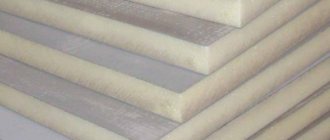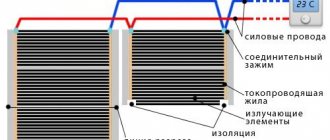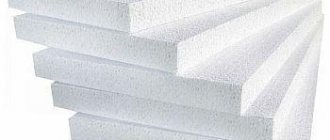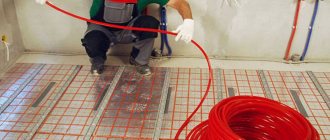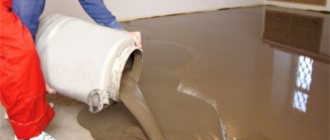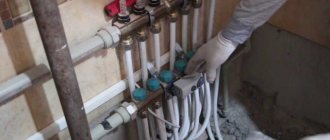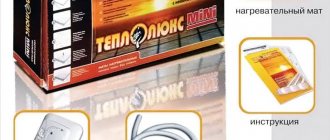Why do you need to insulate a heated water floor system?
Any instructions for installing a water heated floor for DIYers indicate that it is necessary to use insulation.
The insulation layer when installing a water floor performs several significant functions. It helps not only to ensure uniform heating of the room, but also, acting as a heat shield, can significantly reduce the energy losses of the system.
A screed laid on top of an insulating layer acquires the properties of a solid heat-transmitting element with a large surface area.
The main purpose of the insulating layer is to evenly distribute heat in the heated room, preventing its leakage through the floor slabs
Thanks to the uniform distribution of energy, the ordered convection heat flow begins to move at the same speed and in the same direction. As a result, evenly distributed heat waves will not form cold and hot areas on the floor, creating the most comfortable conditions for household members.
In addition, thanks to the direction of warm air flows along one course, it is possible to reduce energy costs for operating the system, while maintaining its power unchanged.
Modern thermal insulation mats are equipped with convenient latches in the form of bosses, with the help of which the installation and subsequent fixation of pipes can be done quickly and at the same time reliably.
Rolled soft and hard slab materials are used in the construction of the thermal insulation layer for water underfloor heating systems. Rolled ones are easier to install, but less efficient according to thermal criteria:
- Among slab thermal insulation options, extruded polystyrene foam is most often used, the structure of which practically eliminates the absorption and retention of moisture;
- Organization of the insulating component of the floor system from non-extruded polystyrene foam, i.e. polystyrene foam, requires a mandatory waterproofing device on top of the layer, which does not have to be done when using the material obtained by extrusion;
- To facilitate the procedure for installing an underfloor heating pipeline, it is better if there are markings on the outer surface of the slabs;
- The simplest and most convenient insulation option now is polystyrene boards with a convex relief, which performs a lot of useful functions;
- The bosses of polystyrene mats allow you to clearly and quickly install underfloor heating pipes according to the chosen scheme and play the role of markings;
- The relief of polystyrene boards serves as a support for plywood or gypsum fiber boards when performing dry screed;
- In areas where it is impossible to comply with the design spacing during installation, thermal insulation for pipes is used to prevent zonal overheating of the surface;
Peculiarities
The task of underfloor heating, regardless of type and configuration, is to ensure uniform distribution of warm air in the room. Since everyone knows that cold air accumulates at the bottom, and heated air rises, the difference in temperature is quite noticeable for humans. A system of warm electric or water floors minimizes these temperature fluctuations in the home, creating acceptable and comfortable heat exchange.
The main feature of the device can be considered the thermal insulation substrate, which, along with the entire heating system, is responsible for heat conservation. Among the proposed range of similar products on the modern market there are a number of materials that are used to construct the system.
In order not to make a mistake with the choice of raw materials, you should proceed from the tasks that the product will solve as part of the entire installation of heated floors.
Among the main functions of insulation it is worth highlighting the following points:
- The presence of thermal insulation reduces the natural loss of heat that escapes through the coldest areas of the apartment or house to the outside or into the ground. In the absence of any materials for insulation, the level of release of warm masses from the room through the floor surface is 20%.
- Thanks to the installation of insulation, thermal energy circulates proportionally throughout the entire heating area, eliminating unnecessary heating of the floors and other components of the building structure that are located under the floor.
- Thanks to thermal insulation, you can save money spent on heating your home.
- In addition to its main functions, the material provides additional sound insulation, which is important in multi-storey residential buildings.
- The properties of thermal insulation products make it possible to create a protective barrier that prevents moisture from entering the home from basements or soil through the floor covering.
Are you installing a water-heated floor system in a country house and it’s time to lay the insulating underlay? Agree that among the variety of offers of heat-insulating materials offered by manufacturers, it is sometimes not easy to make the right choice.
We will help you determine which insulation for a warm water floor is better. Together with you we will understand all the intricacies of assembling heat-insulating systems. We will examine the characteristics of popular materials and evaluate the key advantages and disadvantages.
Do-it-yourselfers will find installation instructions here. To make it easier to navigate the assortment offered by the building materials market, we have selected videos with recommendations for choosing insulation and installation.
Choosing insulation for water heated floors
Insulation for heated floors contributes to a more uniform distribution of heat inside the room. A material with specific properties (thermal insulation) is an important component of the heated base pie.
In the absence of such a layer, the water heating system functions less efficiently and is not durable in operation.
Cork backing
Cork is an expensive product because it is made from oak bark. Available in rolls or sheets, but there are no differences in technical characteristics. The only difference is the size and thickness.
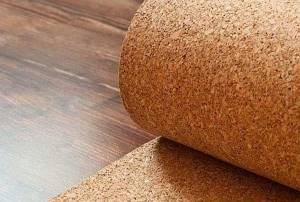
Cork backing:
- has low thermal conductivity;
- waterproof;
- environmentally friendly;
- hypoallergenic;
- elastic;
- light-resistant;
- fireproof;
- resistant to sudden temperature changes;
- not susceptible to chemical influences.
A product made from cork is an ideal option for a water-heated floor system, and if funds allow, then it is better to choose it. The thickness of this substrate contributes to effective saving of heat resources, which is especially important when installed on the ground.
Cork is not subject to deformation and shrinkage when pouring concrete screeds. It cannot be harmed by insects and rodents, mold and mildew, and is also not terrible.
However, it should be noted that the use of cork as a substrate will affect the height of the ceilings, and additional reflective material will also need to be purchased.
Mineral wool
Mineral wool is fireproof, unlike polystyrene foam insulation, but its price is more expensive. It is manufactured in slabs, making it easy to install.
When installed on an aluminum underfloor heating base, this insulation has high efficiency, even when placed on the ground. In addition, it has good noise and heat insulation, increased rigidity, and is resistant to chemicals.
The main disadvantage of the product is that it contains carcinogenic and toxic substances that are dangerous to human health. In addition, cotton wool is hygroscopic and vapor-permeable, and when laying it in a screed, care must be taken to protect it from moisture and steam emissions.

Metallized mylar film
Such products provide high-quality protection against the negative effects of alkali on flooring and cement screed. Aluminum products without an additional layer of thermally resistant polyvinyl chloride film are not used. A positive feature of the products is their high level of reflective properties.
The disadvantages of foil thermal insulation include a low level of insulating qualities. Therefore, when laying products above the basement, standard products with a minimum thickness will not be enough. This problem can be solved using solid insulating mats in several layers. During installation, you should adhere to the technology of laying sheets in such a way that the seams of the materials located below are covered by the seams of the products laid on them. This method will reduce heat loss.
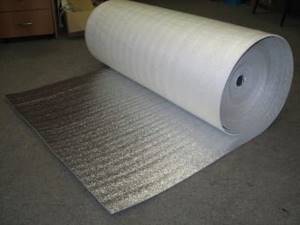
Expanded polystyrene
Expanded polystyrene is the most common type of thermal insulation under water heating floors, and has a fairly affordable price. It provides high-quality protection from water and steam, a high degree of sound insulation, does not deform from exposure to temperature, does not react to chemicals and resists the formation of mold and mildew.
Thermal insulation consists of many bubbles placed in a shell. To add strength to the structure with this substrate, a reinforcing mesh is used. Ease of installation, which even an inexperienced person can handle, also plays an important role in its popularity. In addition, the service life is several decades.
The main disadvantage of polystyrene foam is a fire hazard, so it must be insulated with a foil backing.
Expanded polystyrene comes in several types, which differ in production technology and properties:
- Extruded polystyrene foam is durable and better performs its main function - thermal insulation. It has increased strength, since the particles are tightly bonded to each other. But the vapor permeability indicator is almost zero. Its thickness is at least 3 cm. The slabs are often colored.
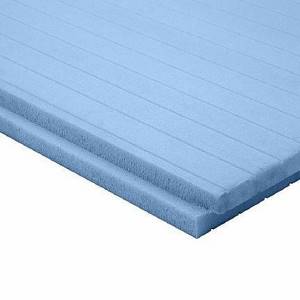
- Foamed - also called polystyrene foam. It has a low specific gravity and a high degree of vapor permeability. It is not recommended for foundation insulation, as it is destroyed by moisture. The color is usually white. It is produced in a non-extruded way, that is, the structure has cells with air channels.
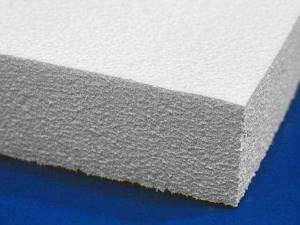
- Penoplex - its cost is not high. It has good performance in terms of reflecting heat flows, therefore it is considered one of the best insulation materials. During installation, a waterproofing substrate is not required, and the process itself is not complicated; it is easy to do the installation yourself. Available in slabs of various sizes, the thickness of which ranges from 20 to 100 mm. The package contains from 4 to 20 sheets - it depends on the thickness of the product.
Main advantages:
- high heat and vapor insulation;
- absence of emissions containing harmful substances;
- resistance to the effects of microorganisms;
- does not allow moisture to pass through;
- has high strength.
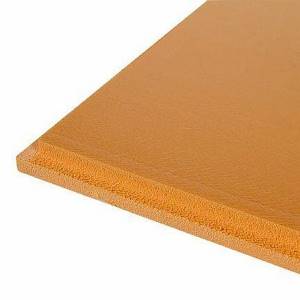
- Profile mats - they are also based on polystyrene foam. They are stamped using a special technological method and covered with a film for waterproofing. The slabs are high-strength products that can withstand mechanical loads. They are equipped with protrusions; water heated floor pipes are laid in them, which facilitates the process of placing the circuit. They have side locks - this simplifies installation and minimizes the presence of seams. The model is considered the most profitable, in terms of financial investments, when constructing heating.

Rolled thermal insulation made of foamed polyethylene
Foamed polyethylene (penofol) is gaining popularity today. It is sold in rolls and has a thickness from 3 to 10 mm. The product is equipped with a foil surface, it reflects heat and allows you to significantly reduce the thickness of the “pie”, since there is no need to lay additional waterproofing made of lavsan or thermal insulation.
There are the following types:
- A - one side has a layer of foil;
- B - foil on both sides;
- C (self-adhesive) - there is foil on one side, glue is applied on the other;
- “ALP” - one side is foil, the other with a special film.
Each type is suitable for use under heated floors, and almost completely copes with the thermal insulation of the device.

The technical indicators of foamed polyethylene and polystyrene are largely similar, the thermal conductivity coefficient ranges from 0.037 - 0.049 W/m °C.
It is worth mentioning the ability of the material to absorb water, which results in a decrease in its thermal insulation properties.
In addition, under the influence of a wet screed containing chemicals, the aluminum foil layer becomes unusable. To combat this problem, manufacturers began to produce the product in sheets with a film-like coating on top of the foil.
Metallized lavsan film is capable of qualitatively protecting the screed and flooring from the effects of alkali. Insulation with an aluminum layer without a thermally resistant coating is not used. The positive side of the product is its high degree of heat reflection.
Important! When laying, the foil side of the product should face up.
Roll material laying technology

Roll material laying technology
Insulation of a wooden floor
To work you will need:
- insulation;
- scissors;
- metallized tape;
- roulette;
- sander;
- antiseptic primer;
- putty.
Self-adhesive insulation is best suited for wood, but if you purchased regular insulation, you can attach it to the surface using a construction stapler or double-sided tape.
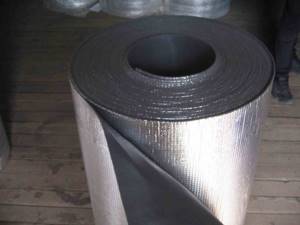
We insulate a wooden floor
Step 1. Carefully prepare the base: remove the baseboards, remove debris and dust, treat the surface with a grinder or sander. If there are cracks, you need to seal them with putty.
Step 2. To better preserve the wood, the floor is primed with an antiseptic composition.
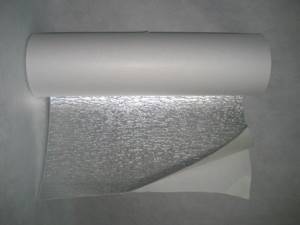
The material is self-adhesive. Peel off the film
Step 3. After the primer has dried, the insulation roll is brought into the room and the required amount of material is measured out. Cutting is done with ordinary scissors. Lay the heat insulator on the floor with the reflective layer facing up, remove the protective film and press the material to the surface.
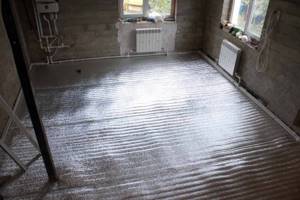
Laying penofol
Step 4. The next sheet is laid end to end with the first one, trying not to leave gaps along the seam. The remaining strips of insulation are laid in the same way, making cuts for communications or niches if necessary.
Step 5. All seams between the strips are sealed with foil tape.

Metallized adhesive tape Izospan
Step 6. Lay the finishing coating - laminate, parquet, linoleum.
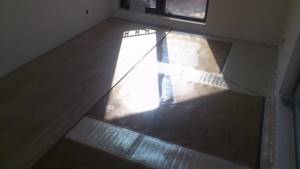
Laying laminate flooring on foil insulation
Insulation of concrete floor
To attach the insulation to the concrete base, a special rubber-based adhesive is used. In all other respects, the technology is similar to insulating a wooden surface.
Step 1. The concrete base is carefully leveled, defects are repaired, and the surface is cleaned of dust.
Step 2. Roll out the roll on the floor, starting from the wall. Take measurements and trim off excess with scissors. Next, the insulation strip is moved to the side and glue is applied to the base. After 1-3 minutes, foil insulation is placed on the floor and pressed. The reflective layer should be at the top. The use of glue is optional, and many builders do not use it. Just so the insulation will not slide along the base and move while laying the finishing layer.

Using foil insulation to insulate a concrete balcony floor
Step 3. The second and subsequent strips are laid end-to-end, the seams are secured with tape. Now you can begin laying the final coating. Linoleum cannot be used as a covering, because the insulating substrate is soft, and the linoleum will be pressed under the weight of the furniture.

An example of laying lag on foil insulation
If the floors are very cold, after laying the foil material, logs from timber are installed, they are aligned horizontally, the space between the logs is filled with ordinary insulation, and plank floors or sheet material are mounted on top.
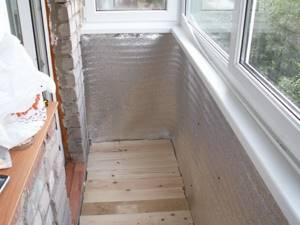
Shelf flooring on the balcony
Laying thermal insulation under “warm floors”
Step 1. The floor slabs are thoroughly cleaned and unevenness is removed using putty or cement mortar.
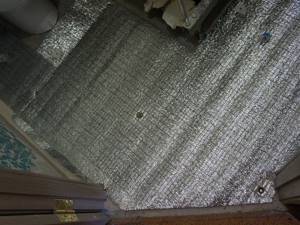
Laying thermal insulation
Step 2. Lay roll reflective thermal insulation, tightly joining the material. Tape all joints with metallized tape.

Laying thermal insulation under “warm floors”
Step 3. The heating cable or heating pipes are laid out over the insulation according to the design.
Step 4. A thin polyethylene film is laid over the heating elements, which will protect the foil coating from the aggressive effects of the cement screed.
Step 5. Mix the solution and pour the leveling screed. When the surface is dry, you can lay the finished floor.
Insulation for various bases
Warm floors are installed not only in apartments, but also in private houses. Some insulation for warm water floors are universal, others are more suitable for specific situations. For example, in some dwellings the thermal insulation has to be laid on the ground, in others on wooden joists. For the first case, one that absorbs moisture well will not be suitable. It is worth considering the general cases in more detail.
Floor slabs
Concrete floor slabs are most often used in apartments or private houses with basements. In new buildings they may be located without a screed, so they will require additional maintenance. Due to the presence of a metal base in floor slabs, they conduct heat very well. This means that if a heated floor is installed on them, its efficiency will be low. That is why a rough screed is applied before starting work. Some craftsmen use expanded clay as a filler for concrete. It creates an additional air layer, which blocks heat from escaping. If there is a basement or other room below where there may be dampness, then it is advisable to lay waterproofing under the screed.
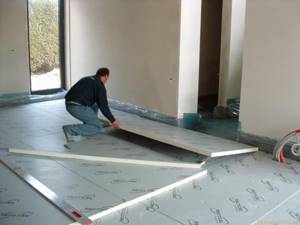
Any of the listed insulation materials will be suitable as an insulator for a heated floor that will be laid on top. For those sensitive to moisture, the rough screed and the insulator itself are waterproofed on top before pouring the finishing screed. Concrete slabs can withstand the load well, so there should be no problems with the thickness of the screed.
Insulation on the ground
There are cases when insulation has to be carried out directly on the ground. The reason for this may be the special design of the house. Before starting work, it is necessary to prepare the foundation well. To do this, you will need to go deep to such a level that there is 50 cm from the bottom point to the top point of the future floor. The bottom layer of soil is well compacted. If there is excess moisture in it, then it is necessary to dry it. This can be done by constant ventilation or using heat guns.
A gravel cushion is laid on top of the compacted soil. Its thickness should be at least 20 cm. It is leveled and brought to approximately the level. Next, medium-grained sand is poured at 20. It is compacted as much as possible and brought below the level. The next step is to install waterproofing, which will prevent the development of fungus and excessive heat transfer. Insulation is placed on the membrane. In this case, it is better to use penoplex. It has excellent compressive strength and does not absorb moisture. It is better if its thickness is 10 cm. Another layer of waterproofing is laid on it, then a reinforcing mesh is laid and a heated floor pipe is laid, followed by a concrete screed.
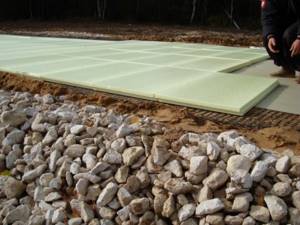
Note! If in your area the groundwater is at shallow depths, then it makes sense to think about building a house on a strip or pile foundation. In this case, there will be less likelihood of moisture rising into the living space and the insulation will last longer.
Floor in a wooden house
Insulating the floor under a water pipe in a wooden house has several options. If the house has a rough concrete floor, then you can proceed as in the case of floor slabs. If there is dry bulk insulation under the beams, then you can use a heated floor system with a dry screed. Extruded polystyrene foam with bosses can be used as insulation. But first you need to level the surface of the wooden floor and lay waterproofing on it. If the ceilings allow, then it is good to use insulation with a thickness of 10 cm.
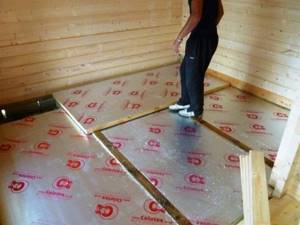
If the house is on a pile foundation, then the subfloor will need to be well insulated. To do this, the finished floor is dismantled and the condition of the joists is assessed. If fungus has already appeared on them, then you will need to scrape everything off and treat it with an antiseptic. Next, boards are packed onto the lower end of the joists to create a small cavity. Waterproofing is placed in it, and insulation is placed on top. You can use stone wool or polystyrene foam. In the second case, with the same thickness as mineral wool, the effect will be better. The next step is to install another layer of waterproofing, and then a heated floor system with a dry screed.
Conclusions and useful video on the topic
Video #1. Choosing insulation for cement screed:
Video #2. A clear example of laying mats:
Video #3. Installation of roll insulation:
In order not to make a mistake in choosing insulation for a water floor, be guided by the technical characteristics of the room, taking into account not only the thickness of the product, but also the maximum permissible compressive load.
By choosing a heat insulator wisely and observing all the details of installation, you can create a reliable foundation for arranging a functional floor water system.
Would you like to talk about how you selected and installed insulation under the heating floor in your home? Have questions or valuable recommendations? Please write comments in the block below.
A warm floor cannot function normally without appropriate insulation. When operated with unsatisfactory quality of thermal insulation, with the presence of cold bridges from the screed to the foundation, very large heat leaks will occur. The situation is characterized, for example, as follows: “With a heated floor, the boiler turns on 2 (!) times more often.”
Heat leaks
One of the advantages of a heated floor system is increased energy savings. With high ceilings - up to 50-70% compared to radiator heating. With ordinary ones, up to 2.60 m in height, up to 10 - 25% savings depending on the building itself.
But if you do not insulate the heating screed properly, you will simply be surprised at the huge energy costs, which will not make the house warmer.
Heat leaks through an uninsulated ordinary floor, whose temperature is +12 - +17 degrees, are relatively small - 10 - 15% of the total energy losses of an “ordinary house”. But if this base of the floor is heated to +30 - +35 degrees C, then all the rodents gathered for this occasion will be grateful to the generous heating of the underground...
It is clear that the thickness of the layer should provide some economic feasibility - what thickness and what kind of insulation should be used for a heated floor? Let's clarify this point.
What insulation to use
Extruded polystyrene foam - this name for insulation can be read in almost any correct manual about creating a warm floor.
But when the consumer finds out the price of this material - more expensive than polystyrene foam - then he begins to be tormented by vague doubts about the correctness of this choice. In addition, it is known that high-density foam plastic, the same as that of extruded polystyrene foam - 35 kg/m3, can also withstand the weight of a concrete screed along with the loads of an ordinary house.
But it is still not recommended to use ordinary polystyrene foam (foamed polystyrene).
With polystyrene foam it’s more problematic
The fact is that for ordinary polystyrene foam almost no one will give a guarantee about its quality - whether it really has the declared density, homogeneity of the material, and a high-quality chemical formula.
How thick should the insulation be?
The retail chain offers materials of a certain standard thickness. The required thickness of thermal insulation in your case is determined by the conditions of the heating system design. The laid layer of thermal insulation in the case of using extruded polystyrene foam on the first floor must be at least 100-115 mm. If polystyrene foam of the required thickness is not available, thermal insulation is laid in two layers (50 + 50 mm).
To lay water floors on the concrete floor of the second floor, you will need a thermal insulation layer of much smaller thickness, 25-35 mm. We have already talked about the density of foam plastic earlier. The optimal density for thermal insulation foam should be 38-45 kg/m3.
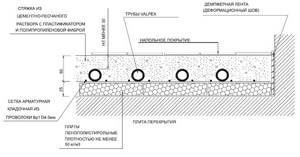
Functions of construction mats
Expanded polystyrene for underfloor heating ensures the proper functioning of the heating structure. To do this, it is important to provide a good base for the warm water floor. Mats help distribute heat over the entire surface and retain it even after the energy supply for the functioning of the heated floor is stopped.
Also, such mats provide complete insulation from cold air. Thus, during cold weather, cold will not penetrate into a room with a warm water floor. Condensation does not form if such a substrate is present. Accordingly, there is no mold on the walls either.
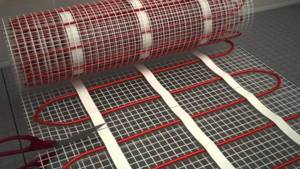
Material structure Source allelectrics.ru
